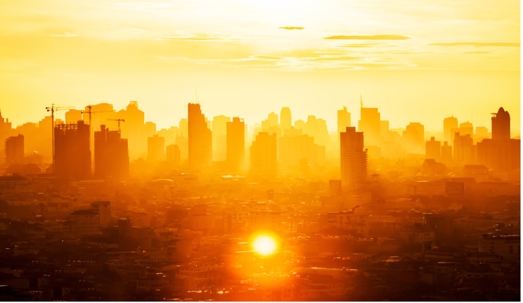An Ever-Hotter World
You’ve probably heard that the world is getting hotter. Global warming and greenhouse gas emissions are changing the ozone layer and as a result, temperatures are climbing.
In 2023, 7.8 BILLION people experienced above-average temperatures. Overall, the temperature increased by 1.3 degrees Celsius over pre-industrial levels. A new record for a world where the temps keep getting hotter and hotter!
Orlando experienced its hottest year ever in 2023 and had 100-degree-day in August for the first time since 2015.
All the research suggests that the world will not get cooler. Temperatures will only climb.
The increase in temperature is worse in cities. Because of the concrete, asphalt, and packed spaces, rising temperatures are not only uncomfortable, but dangerous. Architects, engineers, and city planners all over the world are developing strategies to keep cities cool in an ever-hotter world.
Green Roofs and Walls
Green is good.
Increasing the greenery in urban areas through the installation of green roofs and walls helps to absorb heat and reduce the urban heat island effect. These vegetated surfaces provide insulation, filter air pollutants, and enhance biodiversity.
Singapore’s success at lowering the temperature of urban areas can be recreated in other cities. They planted greenery and foliage on rooftops, as well as on the exterior walls of the building decreases temps by absorbing sunlight before it hits the surface.
Many cities are planting more trees. Trees help move heat higher up into the air. They release water vapor into the air, which helps lower temperatures. Dense foliage keeps sunlight from being absorbed into concrete and asphalt.
Researchers say that planting trees is the most effective kind of climate management. The bigger the green space, the greater the benefit.
Parks and green areas that surround buildings also help cool down areas by pushing cooler breezes out and releasing moisture.
Medellin, Colombia planted 880,000 trees along 30 green corridors, reducing the average air temperature by 8 degrees Fahrenheit!
Water Features
Everyone loves waterfront property, but not every building can be situated on a beach!
Most buildings can, however, have a water feature.
City planners and landscape architects are inserting water features in new property developments. Ponds, fountains, and water sculptures can help cool areas because they release moisture and help lower the temperature.
Building Design
In addition, builders and construction experts are focusing on the architecture of buildings focusing on making them energy efficient and heat-resistant.
New building designs incorporate cross-ventilation and elements of thermal mass to help control temperatures. The surface material, the placement of the building, and the angles of the walls are all part of climate-conscious design.
One recent design featured a V-shaped building with a pond at the mouth of the V. The cool breeze and water vapor from the pond funnels in toward the building, lowering the temperature and decreasing the amount of work the air conditioning had to do.
City planners are also paying attention to the height of buildings. When new construction is being done, the heights of the buildings must be varied. Tall, medium, and short buildings should intermingle. Too many skyscrapers trap the air and raise the temperature between the buildings.
Cool Roofs and Cool Pavements
Why are roofs black? Black absorbs heat and light and raises the temperature of the roof.
New light and heat-reflecting finishes reduce heat absorption. White roofs can reduce the ambient temperature by 3.5 degrees. Currently, New York City has 20 million square feet of rooftops with reflective paint.
Did you know that a hot sidewalk in the summertime can range from 120-150 degrees Fahrenheit?
Innovative pavement coatings with high solar reflectance and infrared emissivity properties are being developed to retrofit existing pavements. These coatings can be applied to roads, parking lots, and sidewalks to reduce surface temperatures and improve comfort for pedestrians and cyclists.
Interconnected Cooling Systems
What if each building didn’t have its own air conditioner, but several buildings worked off of one system?
Engineers are developing district cooling systems that utilize centralized chilling plants to provide air conditioning to multiple buildings. These systems are more energy-efficient than individual building cooling units and can utilize renewable energy sources for operation.
ServiceOne Keeps Orlando Cool
We can’t claim to keep all the cities of the world cool, but we’re doing our part to keep Orlando comfortable! Whether you own a home, a business, or a small commercial property, we can help you beat the heat of an ever-hotter world!
Call us.
ServiceOne Air Conditioning and Plumbing can help you find the perfect system for your needs, your budget, and your building!


